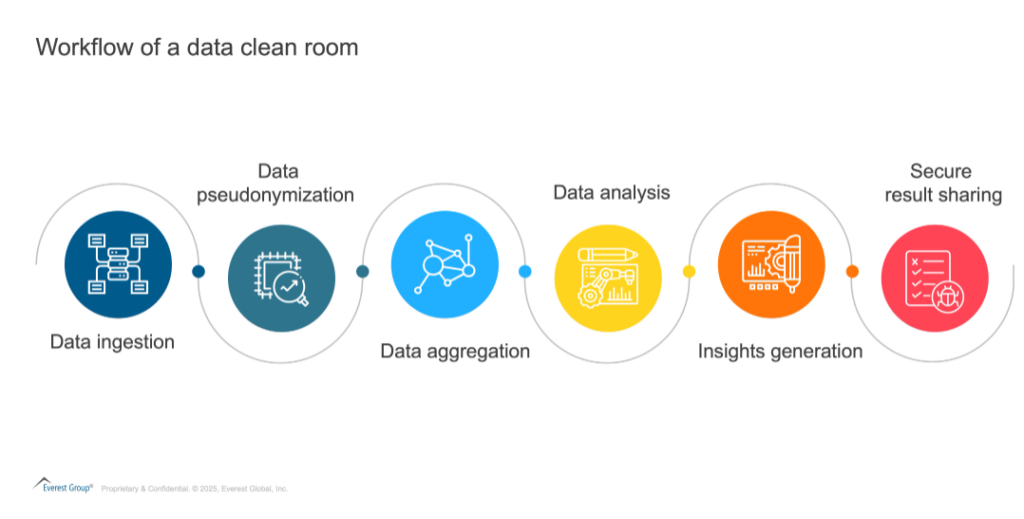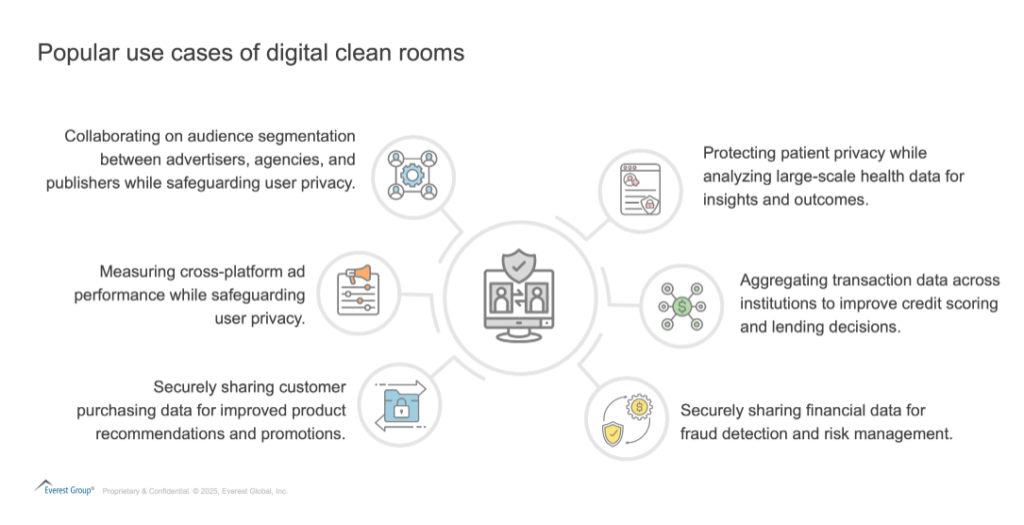Unlocking the Potential of Sensitive Data with Data Clean Rooms | Blog

In a significant step toward data security and privacy, Databricks recently announced the general availability of its Data Clean Room (DCR), offering which aims to provide a platform to safely share and analyze sensitive data, among multiple parties.
While leading companies such as Mastercard, Intuit, and AppsFlyer have already started using these services, Databricks has additionally added HIPAA compliance features, which can accelerate adoption among healthcare organizations.
However, Databricks is not the first to invest in this segment. Snowflake – a close competitor to Databricks – acquired Samooha, a DCR technology provider in late 2023, and has since then integrated it within the Snowflake ecosystem and launched it as Snowflake Data Clean Rooms.
Reach out to discuss this topic in depth.
Hyperscalers like AWS, Google Cloud, and Microsoft Azure have continued to expand their own clean room offerings, leveraging their extensive cloud infrastructure to provide scalable and secure solutions. These developments have highlighted the potential that DCRs hold in today’s modern data ecosystem where security and privacy are key priorities.
It has been well established that sharing data for greater collaboration can bring significant advantages to the stakeholders. But when it comes to sensitive data such as customer information and financial details, sharing without caution can lead to privacy breaches and compliance nightmares. This has made organizations cautious of fully utilizing the potential of their data estates.
Enter Data Clean Rooms, a solution which promises secure collaboration for sensitive data. They do this by creating controlled virtual spaces where enterprises can safely share and analyze sensitive information.
As a first step, DCR collects data from various sources or parties. Then, it pseudonymizes the data (replacing personal identifiers with pseudonyms) to ensure privacy, followed by combining and aggregating it for analysis.
Once the data is ready, businesses can run analyses and generate insights, all while ensuring privacy is maintained. Finally, these insights are shared securely, allowing stakeholders to collaborate without exposing any sensitive data, as shown in exhibit 1.

Exhibit 1: Workflow of a data clean room
We can already see some green shoots in DCR adoption!
By securely sharing data with trusted partners, companies can build stronger, more strategic relationships that open new revenue opportunities. For instance, a retail brand could team up with a logistics company to analyze buying patterns and inventory data, helping both sides optimize supply chain management, cut costs, and offer more personalized services. DCRs also allow for more targeted marketing, boosting customer engagement and loyalty. Plus, over time, they help save on compliance and risk management costs by ensuring data stays secure and businesses stay compliant with privacy laws.
Clean rooms are gaining fast adoption across various industries and functions, starting with marketing and expanding into other areas as well.
Exhibit 2 highlights some popular use cases of digital clean rooms.

Exhibit 2: Popular use cases of digital clean rooms
DCRs tick many boxes for secure collaboration, but are they a silver bullet?
While data clean rooms offer great benefits, they do have some limitations. Integrating data across different systems can be tricky, and these initiatives can be resource intensive. Also, they rely on the quality of the data shared—poor data can still lead to unreliable insights.
Hence, before enterprises take the plunge, it will be critical for them to carefully evaluate the potential they can unlock based on the enterprise’s unique context.
Here are a few preliminary questions for enterprises to get started:
- Are you leaving value on the table by not analyzing certain datasets due to privacy concerns?
- Are there significant business cases which can justify the investments in clean rooms?
- Are you in an industry which is highly regulated, and security/privacy breaches can make or break your data strategy?
- Are your peers investing in this solution?
- Do you have the talent resources to maintain DCRs on a regular basis?
If you found this blog interesting, check out our Demystifying Data Security – A Comprehensive Guide To Data Security | Blog – Everest Group, which delves deeper into another topic regarding the data sector.
If you have more questions regarding Data Clean Rooms, or if you need help in answering questions regarding any of the above, please feel free to reach out to Suseel Menon ([email protected]), Mansi Gupta ([email protected]) and Ishi Thakur ([email protected])